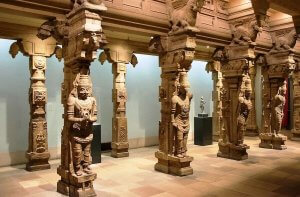Blending smells with music being played in real time at clubs and concerts concerns a phenomenon known as aroma jockeying. This is a logical outgrowth of the need today for a a new edge of discovery, so to speak, that involves pushing the experience envelope of live entertainment to expand sight and sound to new, […]
Ambient Scent Marketing Systems For Museum Environments
The concept of time has fascinated mankind since the dawn of civilization. In primitive eras, night and day were the only quantifiable intervals. Museums are time travelers in their own particular way, but unlike clocks and watches that specifically measure the elusive, intangible passing of life’s moments, they capture them forever for the entire world to see.
Until the last few decades, seeing artifacts or artistic works was all any museum observer could do, rendering exhibits one-dimensional experiences. With the advent of technological advances and innovations in lighting, design, vaporous odor control and scent marketing, museums experiences and interactive displays take on a life of their own and have the potential to transport the viewer on a multi-sensory carpet ride to another time and place.
Scent and Nostalgia
Understanding scent’s powerful connection to the limbic system in our brains that controls memories and emotions and harnessing that supremacy along with other sensory effects can transform a museum visitor from a passive passerby to an immersed participant. Nostalgia and memory formation are always enmeshed with specific scents, whether it be those of holiday season dinners and family gatherings or joyous, idyllic summer vacations spent at the seashore.
Our limbic system is considered the primeval part of the brain because the same structures that comprise it were also present within the brains of the very first mammals to inhabit the earth. Knowing this cements the understanding of why our olfactory sense has such an impact on memory, mood and emotion. Smells also unify us in the sense that certain odors are offensive to all humans mostly because they warn of danger. One example of this would be smoke. Rotting food, also, is a smell no one ever appreciates unless he or she leads a secret, parallel life as a cockroach.
According to distinguished professor of neurology at the University of Florida, Dr. Ken Heilman: “Smells do bring back memories. Scent goes into the emotional parts of the brain and the memory sections, whereas words go into the thinking parts of the brain. This is a plausible explanation for why splashes of recall that are sparked by aromas are often more emotional than tangible and take us back to early childhood.”
Scenting And The Museum Experience
Traditionally, historical and cultural museums have always had one basic focus, which is the preservation of artifacts, masterpieces, ephemera and memorabilia that showcase various eras in our past. It is, however, the ways in which they go about this task that set themselves apart from each other. Whether a small museum or large, the key to successful exhibits entails establishing an atmosphere that completely envelops the visitor.

Visiting the past from behind the cold sterility of glass cases and experiencing it are obviously two different things. Older and contemporary museums have brought history to life by becoming new sensory destinations for their guests. They create a setting where visitors can encapsulate an entirely diverse cosmos of sight, sound, taste, touch and smell in their minds’ eye.
However, in the case of older buildings, the experience can be hampered by musty, stale odors, which have a negative effect on the enjoyment and concentration of visitors. In the case of modern museums,
Customized fragrances and scent systems provided by our ambient air-care specialists are vital assets in the utilization of memorable sensory effects. They make the museum experience more comprehensive. Scents serve to recall memories, create moods of comfort or unease and stimulate conversation. Some example include: the salty scent of the sea for maritime and pirate exhibits or the musky smell of the earth and intoxicating perfume of wildflowers within a jungle setting to accompany the cacophony of animal sounds.
The Concept of Smell In The Modern Museum
The most formidable example of museum scent utilization to date was the 2012 New York Museum of Art and Design’s exhibition entitled: The Art of the Scent (1889-2012). It was the first to honor and appreciate fragrance as a true art form rather than a commercial product.
According to the curator of the department of olfactory art, Chandler Burr: “The fundamental goal of the department is placing scent as an artistic medium alongside painting, sculpture and music. For however brilliant or extraordinary the greatest scents may be, they are not recognized as works of art, and the artists who create them are not recognized as artists.”

The exhibit included 12 fragrances hand-picked by Burr to represent the major aesthetic schools of fragrance design. His biggest challenge was to inspire visitors to break through their emotional responses and memories and rise to an intellectual platform where they could think critically about scent design.
The exhibition hallmarked the evolution of modern perfumery beginning with the first perfume to blend natural with synthetic ingredients (Aimé Guerlain’s Jicky 1889). It follows perfumer, Ernest Beaux, who in 1921 translated Coco Chanel’s vision into the first modern fragrance (Chanel No.5). Other scents featured included: Oliver Cresp’s cotton-candy-scented, Angel (1992) and Daniels Andrier’s Untitled (2010.)
The Authentic Smell Of History
Recreating history in the name of the pursuit of knowledge is a complex affair that requires collaboration on a multitude of levels, for all will fail if authenticity does not prevail over every aspect of every display and exhibit. Behind the scenes this necessitates meticulous detail, technology, planning, design and atmospherics that blend to create an authentic historical setting that will engage all the senses and spark curiosity. The power of scent, as lovingly and carefully developed by our ambient air-care providers, cannot be underestimated.
To truly imagine what it feels like to be somewhere else, a visitor must be thrust into an historical landscape. A site that was once a working plantation from times past, for example, would focus on recreating and diffusing those smells from the dust of every day life originating from the kitchen, wine cellar and living quarters of the day. These could include: raw tobacco and cotton, cottonseed oil, liquid smoke (for cooking in slave lodgings) salt pork, cornbread and hominy, which were the primary foods for slaves and the reason they were so malnourished.
History is the quest for the wisdom and understanding of the times in which we live. How we got where we are can only be ascertained by delving into where we once were socially, culturally and economically. Civilization and our destinies are marked by inquiry, innovation, scientific discovery and natural occurrences. The passage of knowledge from generation to generation via narratives and documentation may bear witness to a particular heritage, but “tribal knowledge” is limited in scope because it cannot recreate the complete and complex panorama of a specific period in time.
Museums are immersive venues that create a window into another place and time. Our ambient air-care applications in these settings are invisible and unifying, permeating consciousness while simultaneously reinforcing a brand and attracting visitors. While all senses should be harnessed to create that exclusive museum experience, fragrance stands alone when it comes to its power to alter mood and perception in a way that other accoutrements, such as lighting or sound, simply cannot do.
Air-Scent International History And Scenting Solutions
We are dedicated to ambient air care and odor neutralization and have been in continuous operation since 1946. Both a leader and pioneer within the ambient air-care industry, we are most known for our impeccable customer service reputation, superior products and masterful ambient scenting and marketing solutions for all types of commercial enterprises including museums.
Our ambient air-care masters fully understand that scent alone has the power to capture the attention of any museum audience more than any other medium known to modern advertising. Used properly, it can elevate any large exhibition into an unforgettable series of lingering memories. The size and scale of a museum and its exhibits are the determining factors in the selection of ambient scenting and odor control strategies.
Infusing large museum events with scent may seem easy, but in truth requires skillful and careful analysis. The selection of a fragrance for any large event must mirror the venue in which it appears, but never dominate it. It functions more as an extra layer of intangible intrigue. It is, perhaps, a process somewhat akin to a woman spending hours on her make-up in order for her to appear “natural.”
HVAC And Non-HVAC Air Freshener Systems
Our air-care diffuser systems are designed to provide full linear effectiveness and are available in different sizes and settings to accommodate museums of all types. Our consultation teams are always there to answer questions about operations and performance. Here are some prime examples of what they can offer.
-
The Aroma Beam Diffuser
In the case of larger museums areas, such as reception rooms and lobbies, the Aroma Beam dry vapor fragrance diffuser system is the best choice. It is unbeatable when used in conjunction with the unique cartridges that are customized for superior dry, linear diffusion for up to 30 days.
This app-controlled, state-of-the-art ambient air-care system features liquid-free Scentsia refill cartridges that consistently combat malodors and offer a myriad of scent experiences that can be altered for holidays, seasons or themes. Customized scents can also be developed to suit any setting, mood or purpose.
For large museum events such as exhibit openings or special venues, diffusing a particular fragrance, especially under the professional guidance of the fragrance masters at Air-Scent, translates into a new plane of recall, bursting with rich and colorful images, sounds and alluring aromas associated with that specific exhibition.
-
The Aroma One Restroom Hygiene Dispenser
The Aroma One small area fan air-freshener is perfect for enhancing restrooms and other small areas. This effective dispenser is an odor-neutralizing system, which both eliminates airborne odors and at the same time, offers superior, linear, aroma enrichment for any small space, particularly but not exclusively for restroom-specific malodors.
Some of its most desirable features include: the contemporary design with optimal air flow; its capacity to hold diverse proven effective refill types; superior air velocity fan blade; its easy conversion from battery to electric (for larger areas) and its innovative nesting tray features, such as the on-board drip guard, ventilated refill holder and air-flow retardant, which can lessen output if desired.
-
The Aroma Styler HVAC Diffuser
This vapor cold mist HVAC Aroma Diffuser is specifically designed for 3-way use in portable wall mounting and HVAC systems. It is perfect for all size areas such as elevators and hallways linking exhibit chambers, and especially the exhibit areas themselves. This extremely versatile ambient air diffuser system is available in three different sizes; Gamma, which covers up to 63,000 cubic feet; Beta for areas up to 21,000 cubic feet and Alpha for spaces up to 10,500 cubic feet.
Air-Scent International’s Progressive Technologies
Our Pittsburgh-situated Technology Center, keeps our fragrance development perfumers and research chemists always a few steps ahead of competitors. Here, innovations and “small miracles” in the world of industrial science are an every day affair. Our laboratories are equipped with the best tools that money can buy. These include the latest in gas chromatography, mass spectrometry, headspace analysis, distillation, extraction and quality control technology.
In Conclusion
The power of scent as a statement is no more evident than in its deployment in museums. Although smell is among our five obvious senses, in its own way it is a sixth one as well because it so deeply impacts our moods and emotions. Tapping into this aspect can be a boon to a curator seeking to increase both interest and traffic to a particular museum. Whether it is a specific inter-active exhibit or a general presentation to attract new visitors, the allure of scent is a gentle and very fragrant attention trap.
Contact our scent experts today and plan your next special museum exhibit with seventy-plus years of air care technologies.
Final thought on museums: Museums are managers of consciousness. They give us an interpretation of history, of how to view the world and locate ourselves in it…. ~ Hans Haacke
You May Also Be Interested In
In the world of retail, the power of ambiance cannot be underestimated. Discover how ambient scenting and thoughtfully chosen fragrances can captivate customers and elevate the shopping experience, leading to increased sales and heightened emotions within jewelry stores.
In maintaining a hygienic and pleasant environment, regular trash chute cleaning proves indispensable for any property. Equally crucial are commercial-grade air freshener systems, ensuring continuous freshness, and eliminating unpleasant odors that may deter occupants and visitors. Discover the vital importance of these two essential practices in this article.


